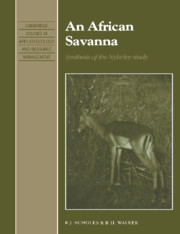Book contents
- Frontmatter
- Contents
- Preface
- I Nylsvley in an African savanna context
- II The key determinants: water, nutrients, fire and herbivory
- III The carbon cycle
- IV Community and landscape pattern and change
- Part V Lessons from Nylsvley
- 16 An overview of savanna ecology
- 17 Managing savannas
- 18 Reflections on ecosystem studies
- Bibliography
- Index
16 - An overview of savanna ecology
Published online by Cambridge University Press: 06 October 2009
- Frontmatter
- Contents
- Preface
- I Nylsvley in an African savanna context
- II The key determinants: water, nutrients, fire and herbivory
- III The carbon cycle
- IV Community and landscape pattern and change
- Part V Lessons from Nylsvley
- 16 An overview of savanna ecology
- 17 Managing savannas
- 18 Reflections on ecosystem studies
- Bibliography
- Index
Summary
A great deal has been learned about savannas during the past two decades, both as a consequence of the South African Savanna Biome Programme and of the increased interest in savannas in the world scientific community. Compare the state-of-the-art review of savanna ecology before the Nylsvley study began (Bourliére & Hadley 1970) with the range of texts now available, of which this book is just one example (Huntley & Walker 1982; Bourliére 1983; Sarmiento 1984; Tothill & Mott 1985; Cole 1986; Walker 1987; Werner 1991). Over this period there have been significant conceptual shifts within the broad science of ecology as well. It is often difficult to say exactly where and when these ideas originate, but within the South African context, most of them have been introduced through the Ecosystem Programmes.
When the Nylsvley study began, the prevailing view of ecosystems was one of reasonably stable entities, when left to their own devices. Twenty years on, they are seen as frequently being far from equilibrium, with a structure and function largely driven by disturbances. Thus although there are more answers now than twenty years ago, many of the questions have changed as well.
Determinants of savanna structure and function
When the programme began, the only predictive model of savanna structure and function was the two-layer soil hypothesis proposed by Walter (1971).
- Type
- Chapter
- Information
- An African SavannaSynthesis of the Nylsvley Study, pp. 250 - 260Publisher: Cambridge University PressPrint publication year: 1993



